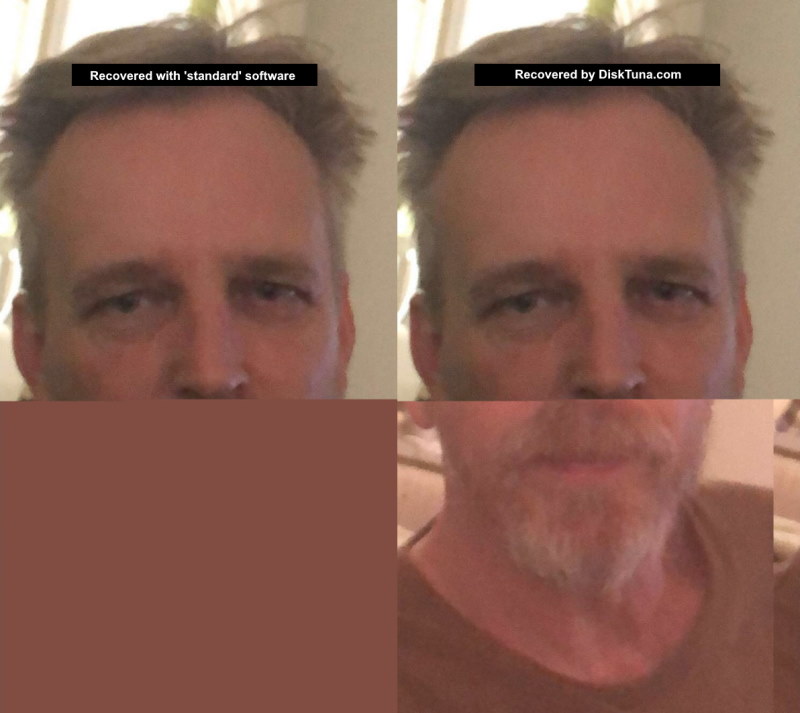In several places on this website I make the bold claim that I may recover your photos even if:
- File recovery or photo recovery software does not.
- File or photo recovery software recovers corrupt photos.
- Other labs can’t or recover corrupt files …
Of course this is a claim you should not take my word for just like that. After all, all recovery tools and labs, well almost all, make the claim they can do the impossible even if others have failed. So please allow me to explain my claim.
File Recovery and Photo Recovery software
I argue that a human can outperform data recovery software where it concerns decision making. For starters, it was a human (or humans) that wrote the software. While writing the software they make assumptions about what the software may encounter in the wild. I think it is impossible to account for each and every situation the software may run into. As such the software is able to handle a limited amount of scenarios.
You can even distinguish between smarter and less smart software if you test it against more complex scenarios. But even the smarter software has it’s limitations. And I argue that a human that can analyze the problem hands-on (so with the corrupt drive in front of her/him) can solve situations, perhaps with the aid of other software (like a disk editor), the software on it’s own can not. In fact I have documented cases where all tools I tried, including professional grade tools, failed where I succeeded in at least partial but meaningful recovery of digital photo material (example case: https://youtu.be/QJIl-oEmjBs).
Hardware issues
Apart from that certain hardware issues can cause a memory card or USB Flash drive to become too unstable for software to handle. Using professional data recovery hardware I can some times still recover data from such drives. A common situation is a flash drive being more dead than alive. It may detect but quickly disappear when file recovery software tries to access it and read data. Such cases require specialist data recovery hardware.
Data Recovery Labs
Without doubt, many data recovery labs are run by or employ some very smart people. Mix in some top quality and highly expensive equipment and you’d assume there’s little they can not solve. I have no problem in admitting they are better equipped and have far more experience and expertise when it comes to hardware related issues that require device repairs and/or reading NAND flash memory directly.
I know several ‘artists’ that can turn meaningless, garbled dumps into perfect logical images, even from unknown chips. Images that can then be performed logical data recovery on. What I have observed though is when something does not work at this stage, so for example corrupt files are being recovered from these re-assembled logical images many labs are kind of lost. At this stage, recovery is pretty much identical to recovering photos from the corrupt drive itself using file recovery software.
Problems with ‘dumps’ from physical NAND chips.
First problem is that a NAND chip can be degraded to the degree where bit errors can not be corrected (NAND memory relies heavily on ECC error correction). Depending on where this corruption occurs it may prevent from an intact file system being reassembled or corruption of individual photos (most common type: JPEG). I can not better them at this!
Rather than the physical extraction of the data, my expertise is to reconstruct files without the need for a coherent file system, even if such files are not in contiguous blocks of clusters. In addition, my more in depth knowledge on for example JPEG helps me recover photos so they can at least be decoded. The latter helps greatly in deciding if a photo is candidate for further repair:

Photo with bit errors, recovered by lab or recovery software (left) and recovered by DiskTuna. Photo on the right can quite easily be repaired.
Incomplete files can also be result of file fragmentation. Sometimes the file system can not be reconstructed which prevents fragmented files from being recovered. I can often recover such photos in one piece, the result looking better than above example.
In conclusion ..
I am not claiming to be better, but I specialized myself in one ‘niche’ and can sometimes recover photos other labs can’t as they rely on third party software to perform the logical recovery (so actual extraction of files). If you ever find yourself in the situation where a lab delivers corrupt or incomplete photos, ask them if they can share the logical image with you. Share with me and perhaps I can better the end result.